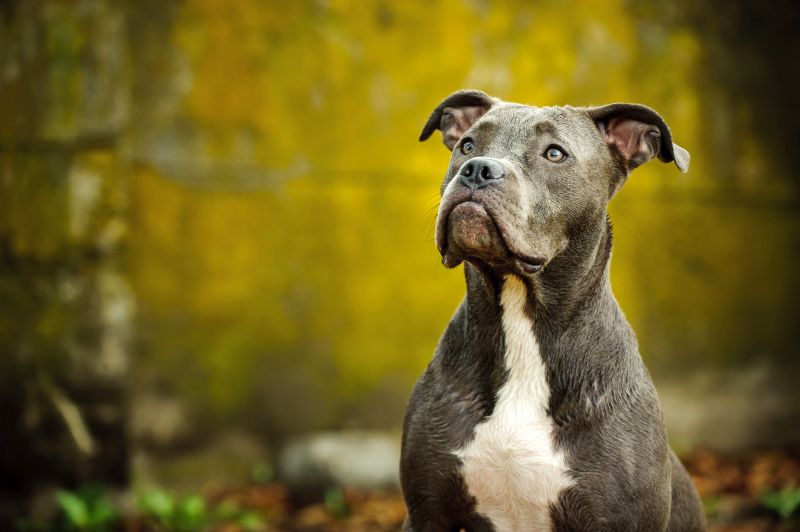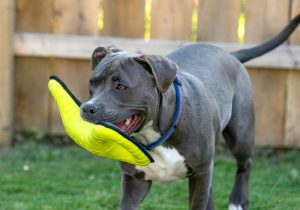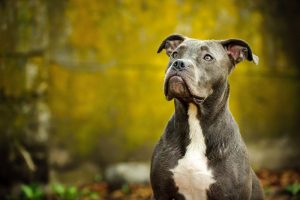

What Is a Blue Nose Pit Bull?
The expression “blue nose pitbull” simply portrays a shading variation of pitties, similar to the expressions “dark” or “wheaten” do when applied to Scottish terriers.
“Blue” is a term habitually utilized in the canine world to depict a dim shading that reaches from light silver to profound charcoal. The expression “bluenose” is a variety of this, as blue nose pit bulls have a dark or close dark nose and a blue coat that might be strong or fixed apparently.
That is it — they’re just grayish-blue pitties with dim noses.
Pitties, Am Staffs, and Their Relatives
Pit bulls are regularly mistaken for other harasser breeds, as the subgroup shares some indistinguishable highlights like an expansive head and incredible form. There are unobtrusive contrasts you can search for, in any case, to differentiate them.
It isn’t in every case simple, however with some training, you’ll see the distinctions, as inconspicuous as they might be.
American pit bull terrier: The authority name of pit bulls, the APBT got his beginning as a catch canine and farmhand on early American residences. He looks somewhat more terrier-like than numerous other domineering jerk breeds and has a less blocky gag.
Staffordshire bull terrier: An establishment type of the APBT, the Staffordshire terrier (or Staffy) has a stockier form than the pit bull. His head is more adjusted in appearance with a more limited, blockier gag and a mark “Staffy grin” articulation seen.
American Staffordshire terrier: A cousin of the APBT, Am Staffs gauge more than their pittie family members. All Am Staff ought to have the “blue nose” appearance, as well, since “red nose” or liver tinge is debilitated by the AKC standard.
American bulldog: Standing up to 28 creeps at the shoulder and weighing as much as 120 pounds, this workhorse of a doggo is far bigger than the APBT. His head is likewise a lot greater and his gag is more limited and more extensive.
American harasser: A moderately new part of the domineering jerk breed scene is this APBT cousin. Showing up more like a bulldog than a terrier, he has a boxier form than the pit bull.
Blue-Nose Pit Bulls 101: Why Are Blue-Nose Pit Bulls Blue?
To comprehend blue-hued canine varieties somewhat better, we need to bring a speedy plunge into doggo coat hereditary qualities.
Regardless of the rainbow of tones and coat designs found in our four-legged companions, there are only two fundamental shades at the base of all: red (pheomelanin) and dark (eumelanin).
Hereditary qualities are the genuine puppy coat, Picasso, blending and blending to make the striking looks we as a whole know, similar to blue, merle, streak, and past. These qualities influence the degree of melanin in each hair shaft from head to toe, making your pooch dull, light, or a secret blend.
Thus, in easier terms, blue nose pit bulls aren’t really blue. Insane, we know!
Bluenose pit bulls really display an appearance best portrayed as “weakened” dark.
The blue hue is a passive quality, requiring two duplicates of the D allele to happen, which means you need two guardians conveying the quality to make a blue little dog.
This makes blue shading more uncommon than some other coat markings.
It additionally implies that blue-nose pitties can deliver non-blue posterity if the other parent in the condition doesn’t likewise have the shading dilution quality.
How Are Blue Nose Pit Bulls Different from Other Pit Bulls?
One of the lone critical manners by which blue nose pit bulls change from other pit bulls is their appearance — they’re as yet unchanged variety.
Some Fido fanciers may say characters change by shading, however, this is a well-established case seen in different varieties with different shading choices as well, similar to Labradors, beagles, and poodles. Characters change from one canine to another and can be influenced by reproducing and raising; your pooch’s jacket has little to do with it.
There are, be that as it may, some slight wellbeing contrasts related to blue shading.
Bluenose pits, like other blue canines, are in danger of a condition considered alopecia that causes slim, dull hair, or going bald. Now and again, this just shows up in youth and clears up, different occasions, it’s a deep-rooted condition.
For dogs with diminishing or missing hair, uncommon consideration ought to be taken in the late spring to forestall burn from the sun. This may mean throwing a light shirt on your pooch, restricting open air time, and putting resources into little guy well-disposed sunscreen.

An existence with a Blue Nose Pit Bull: Do Blue Nose Pit Bulls Make Good Pets?
Like any remaining doggos, blue nose pit bulls make amazing pets for the right proprietors. The pit bull has a scope of requirements that fit in well for certain families yet may cause struggle in others, especially the individuals who don’t possess energy for a functioning friend that needs day-by-day consideration.
Rundown this speedy outline of the variety with us to study blue nose and other pit bull assortments:
Size and Considerations
A strong, medium-sized variety, the pit bull shifts from 17 to 21 crawls at the shoulder and weighs somewhere in the range of 30 and 60 pounds. This is a huge variety in weight, obviously, yet the UKC standard anxieties the significance of extent here. However long your pooch isn’t exorbitantly meager or thick, he’s right where he should be.
With this size comes beast strength that may shock you. Pit bulls are incredible canines worked to get and hold creatures a lot bigger than themselves. With thick necks and wide shoulders, he can without much of a stretch take you off your feet while strolling on the off chance that he dashes at a squirrel startlingly. In light of that, focus on rope preparing.
Coat and Grooming
Pit bulls have a short coat that is reflexive apparently and marginally firm on the surface. Other than blue, they can be all tones and examples aside from pale-skinned person and merle, which are considered disqualifiers by the UKC. Streak, grovel, and tricolor are probably the most widely recognized tones and examples found in pits.
Your pit bull’s jacket will require little support other than periodic washing. Brushing assists with his shedding, as he will leave short, spiky hairs around the house all year. Customary nail management, toothbrushing, and ear cleaning are additionally needed to keep your pebble looking, feeling, and smelling his best. For pit bulls with skin conditions, more incessant or sedated washing might be required.
The pit bull’s jacket offers little protection from the chilly, making speedy potty breaks an absolute necessity throughout the colder time of year. Keep him hot in the chilly climate with a sweater during the day-by-day strolls (simply make certain to pick the size and cut off his attire cautiously, because of your pibble’s enormous shoulders).
Exercise Needs
While the pit bull’s preparing needs are negligible contrasted with different varieties, his everyday physical and mental prerequisites are a unique story. The doggos aren’t for people who need a canine enthusiastic about love seat warming just — pitties need to party.
A functioning canine on a fundamental level, the pit bull needs day-by-day practice accomplished through strolls and patio play or canine games, like readiness. On the off chance that you work extended periods of time, recruiting a canine walker for your pit for a late morning walk may be a smart thought (verging on required).
The best exercises for him include thinking carefully, as well, as an absence of mental incitement can prompt damaging practices, such as biting or annoyance woofing. Things like nose work, strolling games, and tease posts are the first-rate picks for him. Spring posts and other intuitive toys are likewise phenomenal decisions for keeping him involved around the house and yard.
Preparing Your Blue Pit Bull
The pit bull is an astute variety who’s anxious to please, however, he can be obstinate.
While this free streak can be baffling on occasion, keep all preparation positive and award-based, as he’s a major softie under all that muscle. For best outcomes, pack treats for every meeting and change things up infrequently to keep away from fatigue.
Notwithstanding submission and chain preparing in puppyhood, socialization is an absolute necessity when his inoculations take into consideration. He should meet human and canine companions in certain acquaintances with stay away from standoffish quality sometime down the road. In case he’s going to live with felines or other little creatures like hares, early presentation and exercises inhabits are musts, as pit bulls have solid pursuing impulses.
Wellbeing and Health Concerns
Pit bulls are solid, with a common canine life expectancy of 12 to 14 years. They experience the afflictions you’d expect in medium-sized varieties, including hip and elbow dysplasia and luxating patellas. They’re additionally in danger of different conditions, as heart illness, waterfalls, and skin issues. Raiser wellbeing screenings for hip and elbow issues are suggested.
Keeping your pit bull at an appropriate load through customary exercise and taking care of him quality food can ease the weight on his joints. Legitimate nourishment can likewise reduce the danger of some skin sensitivities incidentally found in the variety, like color and added substance hypersensitivities.

Optimal Living Situations and Families for Pit Bulls
The pit bull is a human sweetheart on a basic level. He is troubled simply existing in a pen on the terrace or watching the yard as a gatekeeper canine.
Truth be told, APBTs make pretty inferior watchman canines contrasted with different varieties. Certainly, they may look scary, however, pitties ache for the consideration of individuals and can probably be effortlessly controlled with a delectable treat and some flattery.
Considering that, he’s a house canine and ought to live inside with his kin. He needs consideration routinely and can be somewhat of a Velcro canine in adhering to your side around the house. He can likewise have partition tension, so case preparing may be a smart thought right off the bat.
Pit bulls are acceptable family canines, yet they can inadvertently push over little children in passing. They likewise aren’t generally aware of their size and may demand sitting on your little child’s lap.
Whether or not you have youngsters or not, your pet will be most joyful and flourish when he’s with his human family.
Legitimate socialization helps your pitbull meet new canines and creatures without issue, however, he actually may not be a devotee of living (and sharing you) with them. He’s a terrier deep down, and dissimilar to different varieties like beagles, he probably won’t partake in a load climate with a few different canines around the house.
Legitimate and Social Issues
This one isn’t so amusing to discuss, however it goes with the job of claiming this variety.
Not exclusively are pit bulls and other harasser breeds prohibited by some loft networks, towns, and even nations, however, they can likewise make getting (or keeping) property holder’s protection a migraine. Not all insurance agencies have limitations, in any case, so look around to keep away from an issue and consistently call ahead to check with your transporter before bringing a pit bull home.
Pit bulls are frequently focused on by breed boycotts at canine parks, custodians, and pup childcare too. Checking early is something you’ll become acclimated to doing, lamentably, yet it’s awesome to stay away from issues.
Generally disturbing to numerous proprietors is the social disgrace of having a pit bull.
You may see individuals moving to the opposite roadside while you’re out strolling your canine or hear disturbing remarks focused on your pooch. In these circumstances, it’s ideal to mind your own business and abstain from locks in. Not exclusively will it upset you, yet it’ll likewise resentful your canine. The most ideal approach to retaliate is to help your pit bull be the best illustration of the variety he can be.
How Might You Find a Blue Nose Pit Bull?
You can track down a blue-nose pit bull by looking for a capable raiser. The UKC site has a raiser index you can peruse, or you can look for neighborhood reproducer clubs in your space.
You can likewise look through neighborhood breed saves and asylums, as pit bulls are unfortunately quite possibly the most regularly discovered varieties in creature covers.
As a rule, breed salvages see whole litters of pups gave up alongside their mother, giving you an assortment of coat tones and examples (counting blue!) to browse. Numerous salvages likewise offer rebates or free fixing/fixing of pitties, as well.
Tracking down a moral raiser is crucial in case you’re hoping to buy as opposed to receive a blue nose pit bullpup. Tragically, because the shading is more uncommon than others, some lawn reproducers have tossed wellbeing and conformity out the window for shading, prompting inbreeding and genuine wellbeing concerns.
Blue Nose Pit Bull FAQs
Like the actual variety, there are numerous misinterpretations out there about blue nose pit bulls. How about we tackle the most well-known together.
Are blue nose pit bulls more forceful than other pit bulls?
No; blue nose pit bulls show no conduct contrasts from other pit bulls. Any canine has a penchant for forceful if inappropriately raised, prepared, or reared. All canines ought to be associated in puppyhood with individuals and different canines to guarantee a cheerful, solid, and composed pooch.
Are blue nose pit bulls more costly than others?
A few reproducers may append an exceptional cost to a blue nose pup for the name or extraordinariness, as they are more uncommon than different tones or examples. While a slight distinction in cost might be seen, anything cosmic is a warning. This is a typical issue found in patio raisers trying to benefit off of an uncommon-sounding name, for the most part without the absolute minimum of wellbeing testing. To keep away from cost gouging, look for capable reproducers as it were.
How might you tell if a canine is a blue nose pitbull?
A blue nose pitbull has a charcoal or blackish nose and a dim coat, going from a weakened silver to a dim record tone. While some of the time seen, blue eyes are not a necessity of blue nose pit bulls. Truth be told, blue eyes are a shortcoming as indicated by UKC guidelines.
What’s the distinction between a red and a blue nose pitbull?
Bluenose pit bulls have a blue or close dark nose with dim coat shading, while red nose pit bulls have a liver or brown nose. Red nose pit bulls have a ruddy or tan coat. Both red nose and blue nose pit bulls may have white patches blended in their jackets. Appearance to the side, there are no social or size contrasts between the two.
What amount does a blue nose pitbull cost?
Bluenose little dog valuing fluctuates from one reproducer to another, with variables, for example, area and show lines influencing the general sum. You can hope to pay $500 to more than $1000 for a doggy from most reproducers. Make sure to get some information about wellbeing testing and consistently meet the guardians of your pooch to ensure their personality is sound.
You can likewise track down a blue nose pitbull all things considered safe houses, going from little dogs to seniors with a lot of energy passed on to cause you to remain alert. Reception expenses shift from $50 to $250, fluctuating by the canine’s age and your area. Numerous salvages and sanctuaries offer uncommon limited rates on pit bull receptions too.